What does a mosaic on cucumbers look like and how to treat it?
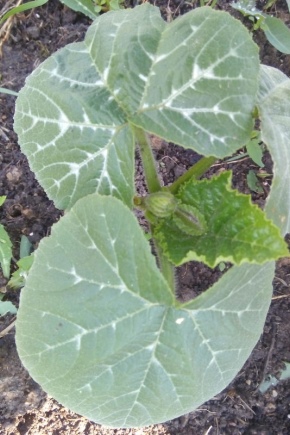
A disease such as mosaic is often found in various vegetable crops. This is a dangerous disease that is difficult to fight, but if it is not eliminated, the plant will eventually die. We will describe below what this disease is, how to detect it and what methods of dealing with it exist.
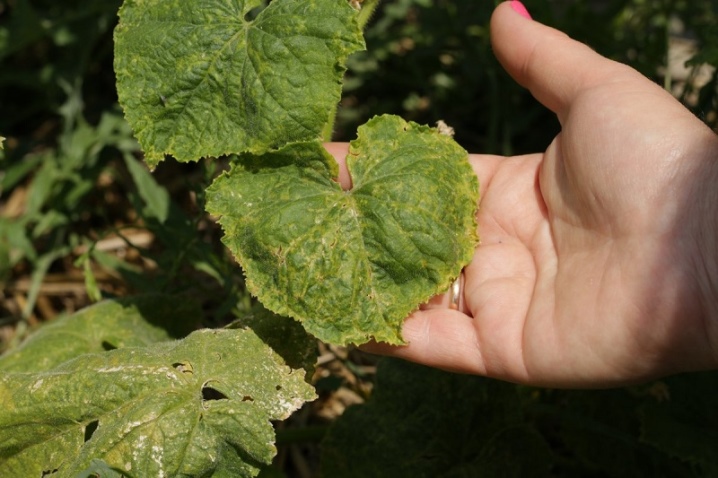
What it is?
Cucumber mosaic is one of the varieties of viral diseases... It affects not only cucumbers, it can also be found on tomatoes, potatoes, cabbage, pumpkin, beans and peppers. This is a dangerous virus that can kill many plants. And it doesn't matter if they grow in a greenhouse or in the open field, absolutely any plants can affect this disease.
The main carrier of the disease is aphids, but it can spread due to diseased seeds, parts of last year's infectious plants, weeds, and also due to the lack of processing of garden tools.
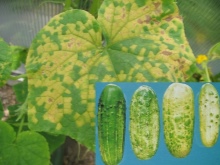
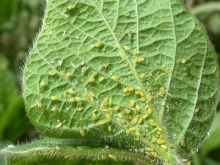

Causes of the disease
There can be many reasons for the emergence of the virus. It can penetrate the soil due to a diseased seed and be in the so-called hibernation for a long time. Various factors can provoke it.
One such factor is wrong temperature mode. Cucumbers love warmth, because of the drop in temperatures, they die. When the temperature drops below +16, they stop growing, and all the nutrients that the plant has accumulated over the entire period begin to be sent to support life. At lower temperatures, the bushes die completely.
High temperatures exceeding +29 degrees are also detrimental to planting. In such conditions, the substances necessary for cucumbers come more slowly. As a result, the activity of development decreases, and with it the immunity of the plant.
Because of this, it becomes easier for viruses to infect plantings.

Diseases can also be caused by high moisture content of the earth or, conversely, its excessive dryness. In too dry soil, the roots absorb the nutrients necessary for the plant much more slowly, the absorption of which, for the most part, occurs only in liquid form.
However, excess moisture lowers the aeration of the earth, which is a good breeding ground for pathogenic diseases. The increased humidity provides favorable conditions for the virus, which easily infects the roots of the weakened planting. Therefore, a summer resident, who expects a good harvest, needs to carefully monitor the moisture content of the earth, watering only after its top layer has completely dried out.
Pay attention to air humidity, because it can also cause the occurrence of cucumber diseases. For cucumbers, the most favorable conditions are high humidity, since the plant is tropical. It is best if the humidity indicator is kept at 85%. If this indicator is lower, then the cucumbers will quickly lose the accumulated water, which is fraught with weakening and, as a result, diseases.
And if the humidity exceeds 95%, then in this case dew will begin to form, which is a favorable condition for the penetration of viruses.

It is important to pay attention to fertilizers... The main thing - do not overdo it with the frequency of their use. If they are incorrectly introduced, there is a great risk of provoking the activity of pathogenic diseases. Many summer residents use a plant feeding schedule.
Be sure to keep track of the amount of fertilizer applied. So, an excess of nitrogen in the earth can lead to the fact that other useful substances will be absorbed less actively, which will lead to a decrease in the immunity of cucumbers and the occurrence of various diseases. Therefore, the deficiency of the substances necessary for the plant should not be allowed if your goal is to get a good, tasty and healthy harvest.
It is also important to carefully choose planting varieties.... Often among them there are those who have a low natural immunity at the genetic level, which increases their susceptibility to attacks by pathogenic viruses. However, thanks to the labors of breeders, there are now many varieties of plants that are known to have strong immunity, thanks to which they are able to withstand various kinds of diseases.
It is these varieties that are recommended to be purchased for planting.
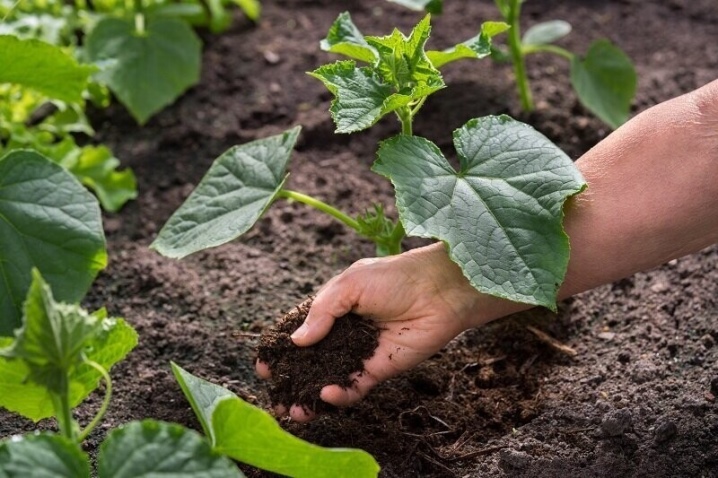
Signs of defeat
Initially, the fact that a disease has appeared on the plant is evidenced by a sharp modification of its foliage and spotting. The foliage becomes wrinkled, after which it dries up and curls up. A large number of light and dark spots are formed on the leaves, which resemble mosaic masonry.
In addition, the cucumber stem is also beginning to change. It bends, a lot of cracks form on it. The flowers on the planting almost stop forming, and the greens turn yellow and dry. At an advanced stage, the plant begins to discolor and eventually withers.
The effect of the disease also affects cucumber fruits. Most often, they simply stop appearing, and if they do appear, then hardly anyone will eat them. The painful condition of the bush is clearly reflected in the fruit. They grow dwarf, with a lot of spots, and their taste becomes noticeably bitter.
Mosaic disease can occur at any stage of planting development. However, most of all it threatens the plant at the seedling stage.
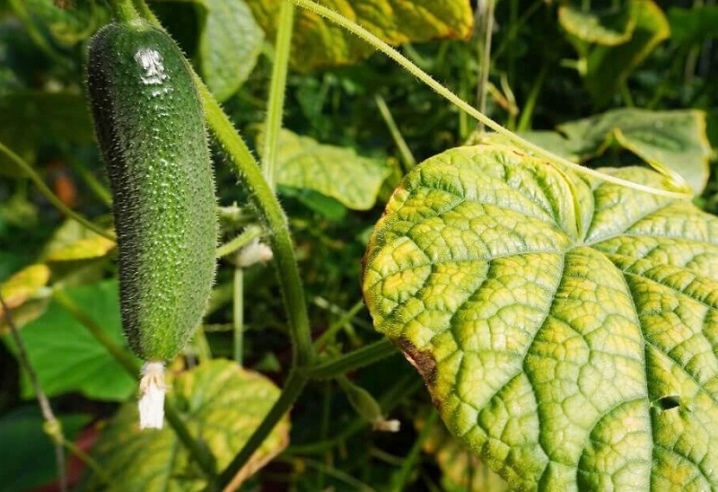
Species overview
Mosaic disease is of different types. In general, the symptoms of all its varieties are largely similar, but there are also distinctive features. At the same time, we note that several types of this disease can manifest themselves on one plant at once. In total, the disease has 4 varieties - tobacco, white, ordinary and green speckled.
- Tobacco mosaics rarely attack cucumbers. Its characteristic features are beige mosaic stains, the appearance of bulges and bumps on the leaves. The foliage itself begins to fade and gradually die off, and the fruits, if they appear, do not develop fully and look deformed.
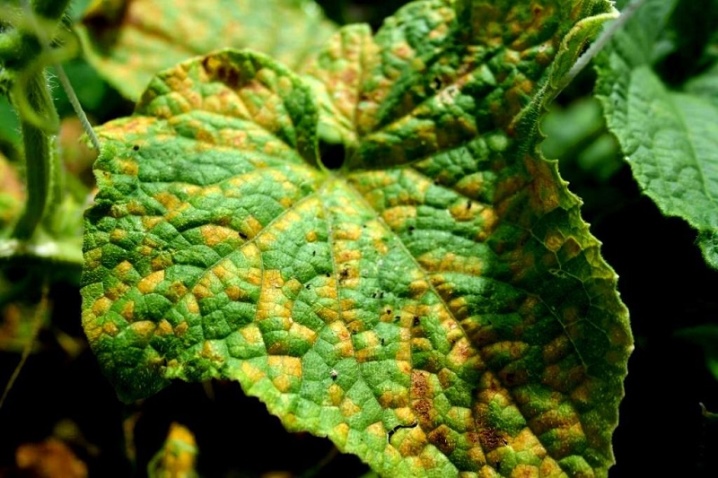
- Ordinary mosaic on cucumbers can be found much more often. If a plant becomes infected with this type of mosaic disease, then a characteristic spot with areas of light and dark tones appears on its leaves, the foliage itself begins to bend down along the edge, the stem cracks, and the inflorescences fall off. The fruits of diseased plantings are characterized by mottling, noticeable deformation and wrinkling.
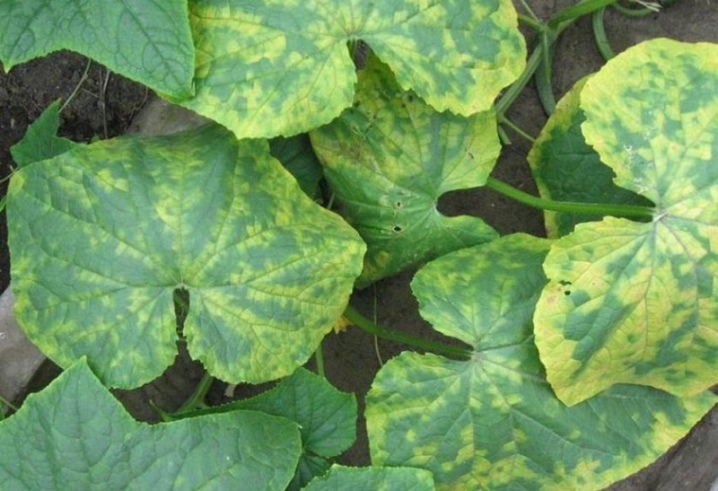
- Green speckled mosaic for the most part, it attacks only those plantings that belong to the pumpkin family. As for cucumbers, most often it can be found on those plantings that grow in greenhouse conditions. Most often, this type of mosaic disease manifests itself due to an increase in the temperature of the air masses. Its characteristic feature is the appearance of yellowness on the foliage, it becomes wrinkled, and its veins brighten. The tops begin to wither at an accelerated rate, and mosaic spots appear on the fruits.
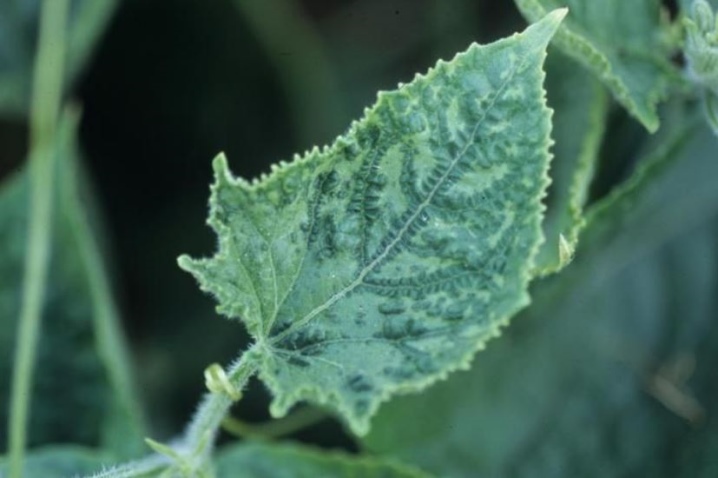
- Concerning white mosaic, then it also often affects cucumbers. It is characterized by a fine yellowness, located near the veins of the plant, light green spots in the form of rings or stars on the leaves, as well as the whiteness of the leaves and a slowdown in the development of plantings.
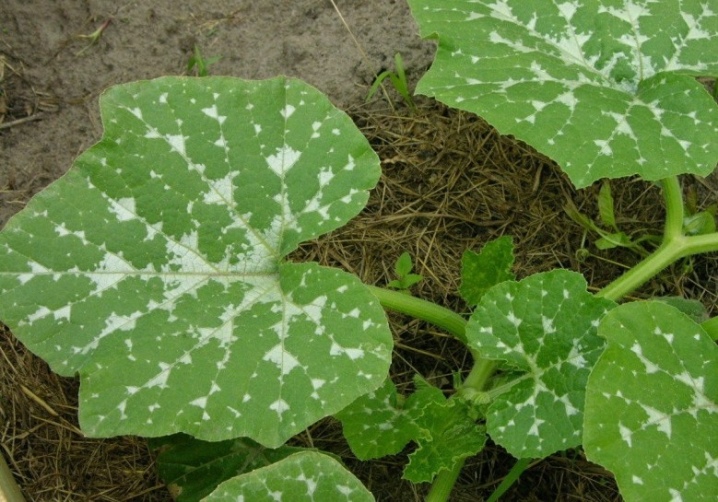
How to carry out the treatment?
Fighting this disease is a complex process. So far, there are no such methods that can definitely save your plant from the virus.
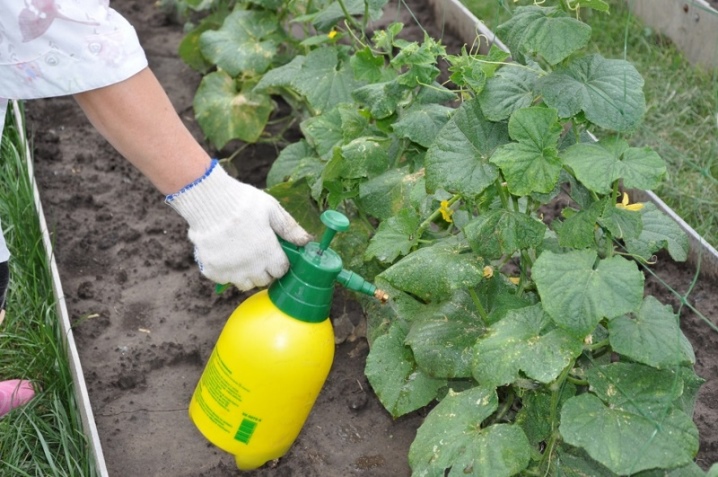
Chemicals
This is not to say that drugs of this kind are able to effectively fight the virus. Often the result from them does not live up to expectations. Nevertheless, chemical methods of processing by summer residents are still used. The most effective remedy among such drugs is "Fitosporin", "Aktara" and "Attelik".
The method for preparing a solution with these substances is as follows: 85 grams of the selected substance is used for 10 liters of water, all this is thoroughly mixed. Next, the resulting mixture must be sprayed on the planting.
This is done at weekly intervals, and in order to avoid the accumulation of chemicals in the tissues of the plant, this is done exclusively during the period of active growth.

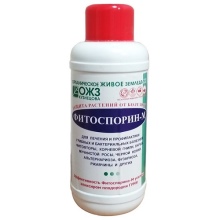
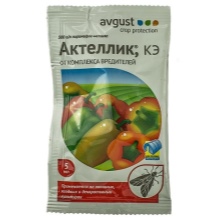
Folk remedies
Home remedies are also useful for treating the plant for the virus and fighting it effectively. They are distinguished by their environmental friendliness, which cannot be said about chemical preparations. Such funds are famous for their high efficiency and long-term results.
Most often, many summer residents resort to using skim milk solution. For its preparation, it is necessary to mix milk whey with water in a ratio of 1 to 2. This solution helps to prevent the active development of the disease and its spread. For a better result, it is recommended to add a couple of drops of iodine to the solution.
In addition to whey, it is often used mullein solution... This requires 1 kilogram of mullein, 10 liters of water and a tablespoon of urea. All this mixes well, after which the plants can be treated with the solution. This mixture contributes to the treatment of the planting, as well as the disinfection of the earth.
For plant treatment, you can also use a variety of solutions based on herbal ingredients, which include dandelion, tobacco and onion husks. However, you should not part with such tinctures.
It is recommended to use them as well as chemical products, with an interval of at least a week.
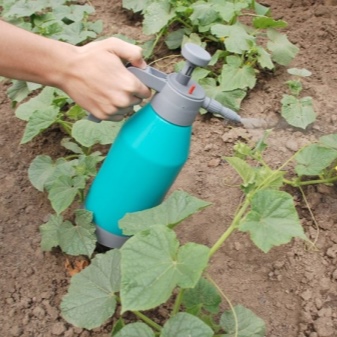
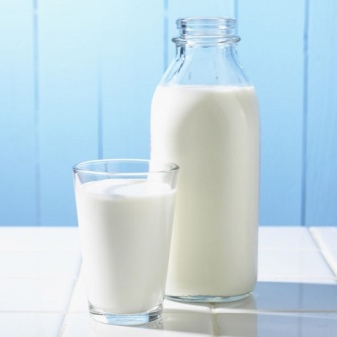
Prevention measures
Preventive measures also in many cases help to avoid the occurrence of pathogenic diseases and prevent their occurrence.
- Take time initially to disinfect seeds... To do this, soak them in a 1% solution of potassium permanganate and leave for an hour.
- Every year in greenhouse conditions replace the top layer of the earth, which is about 12 centimeters.
- Perform thoroughly and regularly weeding. Their roots can be carriers of pathogenic diseases.
- Make sure that pests do not appear on your plantings, especially aphids. Try to get rid of them in the early stages, otherwise there is a high risk of being left without a rich harvest. Pay attention to other pests like ticks, as they feed on plant juices, depleting its supply of nutrients, which leads to a decrease in immunity and the emergence of various kinds of diseases.
- Follow behind the level of air humidity in greenhouse conditions, as well as the condition of the soil. Water the plants well, fertilize them, but don't overdo it.
- Be sure to track nitrogen level in the soil and do not allow a deficiency of other substances necessary for the plant.
- Do not neglect disinfection of garden tools.
- Inspect cucumber foliage regularly for signs of illness. If you find affected plants or foliage, then get rid of them to avoid spreading the disease. This takes a long time, but it will take much more effort to fight the virus.
- Pay attention to the choice of plant varieties. Please read their descriptions before purchasing. It is worth choosing those that are distinguished by good immunity and high resistance to various kinds of diseases.
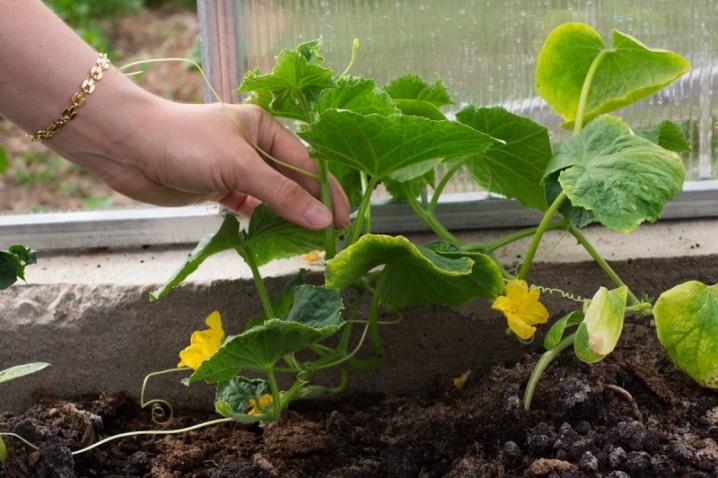
Resistant varieties
The most resistant cucumber varieties are options called:
- "Thumb Boy";
- "Masha";
- "Diva";
- "Martin";
- "Princess";
- "Nightingale".
They are among the fastest growing.
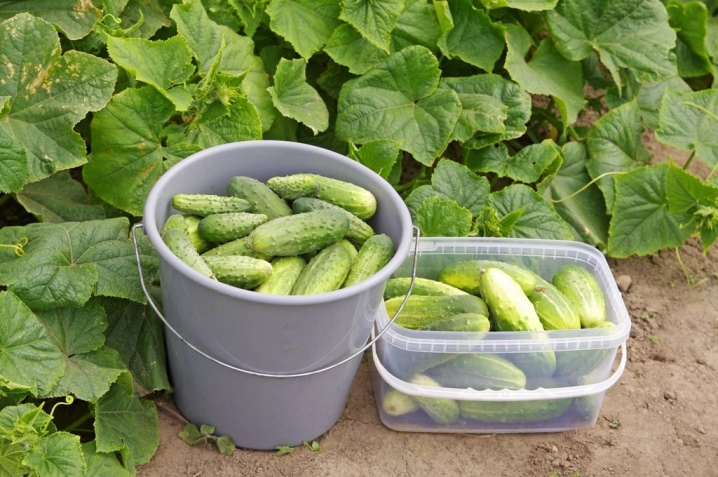
In addition, the following varieties of cucumbers are distinguished, which are resistant specifically to diseases of the cucumber mosaic:
- "Adam F1";
- "Anyuta F1";
- "Gerold F1";
- Danila F1;
- Vicenta F1;
- Capra F1;
- "Merchant F1";
- "Lord F1";
- "Magnat F1";
- "Marinda F1";
- Tais F1.
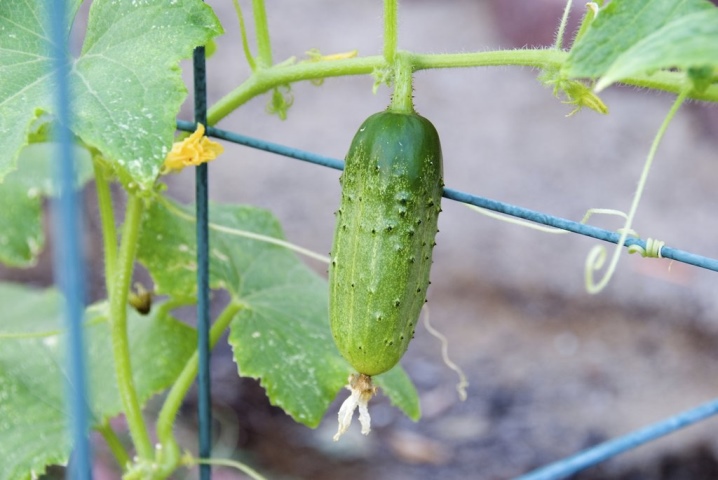
You can find out how to deal with cucumber mosaics in the video below.













The comment was sent successfully.